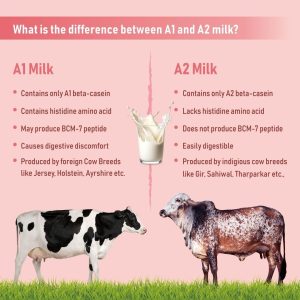What is the difference between A1 and A2 milk?

Difference between A1 and A2 milk:
A1 and A2 milk refer to two different types of milk based on the genetic variation of beta-casein protein found in cow’s milk. The key difference lies in the presence of specific variants of the beta-casein protein called A1 and A2 beta-casein.
A1 milk contains A1 beta-casein protein, which is a genetic variant found in the milk of certain breeds of cows, including Holstein Friesian, Jersey and Ayrshire. These breeds are commonly used in industrialized dairy farming.
A2 milk, on the other hand, contains A2 beta-casein protein, which is the original variant of beta-casein protein found in milk. It is primarily associated with indigenous cow breeds like the Gir, Sahiwal, Kangrej, Ongole, Khillari, Tharparkar, etc,.

The difference between A1 and A2 beta-casein lies in their amino acid composition. A1 Beta- Casein has a histidine amino acid at a specific position (position 67), whereas A2 beta-casein has a proline amino acid at the same position. During digestion, A1 beta-casein can be broken down into a peptide called beta-casomorphin-7 (BCM-7), which is believed to have certain effects on the human body.
According to some studies, BCM-7 may interact with the opioid receptors in the digestive system and potentially contribute to discomfort and digestive issues in some individuals. These issues can include bloating, gas, and gastrointestinal distress.
In contrast, A2 beta-casein does not produce significant amounts of BCM-7 during digestion. This has led to the belief that A2 milk might be easier to digest and less likely to cause digestive discomfort compared to A1 milk.
It’s important to note that individual responses to A1 and A2 milk can vary, and not all individuals experience adverse effects from consuming A1 milk. Some people may tolerate both types of milk without any issues, while others may notice a difference in their digestion or overall well-being when consuming A2 milk.
Related articles
Snack Smarter, Live Healthier - A Better Choice Awaits
When you are hungry, do you reach for a bag of chips or a candy bar? Then stop and just think, are they really good for you? The easily marketable snacks are tempting, but they contain additives, chemicals, bad fats, and excess sugar, all of which contribute to long-term health issues. What if you could indulge in something that is just as good but provides a boost to your health? Amla & Ginger Candy has arrived—a wholesome, flavourful alternative to junk food. The Dark Side of Junk Food Junk food is supposed to be addictive. The combination of excessive sugar/sodium and unhealthy fats makes you crave it so much that you keep trying it out. The downside is it’s damn unhealthy. Weight Gain and Obesity: Processed snacks have many calories but few nutrients, causing you to gain weight. Increased Risk of Diseases: Consuming too much junk food is associated with diabetes, heart disease, and gastrointestinal problems. Low energy: Short bursts of sugar in junk food cause a crash and burn effect. It feels like you're not very energetic. Poor Digestion: Bad bacteria in your gut cause you to be bloated and uncomfortably full after eating the wrong foods. If junk food is doing so much harm, what's the alternative? The answer lies in nature's superfoods—Amla & Ginger Candy! Amla Candy: Each Bite Is A Superfood Indian gooseberry, also known as Amla, contains rich nutrients and a delightful sweet and tangy taste that makes it a perfect snack. Check out why you should treat yourself to Amla Candy: Immunity Booster: Amla increases the body defences due to the abundant vitamin C. Helps with Digestion: Amla contains fiber and very effectively relieves constipation. Anti-aging Aid: Free radicals are fought by antioxidants in Amla, hence giving glowing skin along with thick hair. Blood Sugar Supplement: Heavy meals that spike blood sugar levels are unlike Amla; Amla keeps the sugar levels steady. Ginger Candy: A New Delicious Way to Have Healthy Snacks Because of its therapeutic properties, Ginger / Adrak is said to have been utilised and preserved for hundreds of years. Ginger Candy / Cubies helps with many things, including a taste that is really good. Reduces Constipation: With ginger, you'll have less trouble with nausea, an upset stomach, and even a bloated stomach. Prevents Colds and Coughs: Seasonal illness can be avoided with Ginger/ Adrak as it relieves throat swelling. Helping Metabolism: Want to burn more calories? Ginger/Aadrak is going to help. Reduces inflammation: Ginger can ease sore muscles and joints, which is really awesome for people who are on the go. Why are Amla & Ginger Candy Good Alternatives to Junk Food? Nutrient-packed, not empty calories: These candies are packed with vitamin and mineral goodness rather than chemical preservatives and artificial flavourings. No added toxin: These natural foods are pure and non-chemical-based foods versus junk food, which has lots of synthetic stuff and chemicals. Supports Healthy Lifestyle: To Live Healthy These candies can make you more productive when you 're traveling, working or enjoying a sweet treat. In Conclusion: Switch to the healthy option today! Avoiding junk food is not a compromise on taste. Amla & Ginger Candy is a tasty and healthy alternative to elevate your little hunger and nourish your body with goodness. Experience the natural way of snacking today! Forward this blog to your family and friends, and let's make healthier choices one bite at a time!
Gulkand-The Ultimate Summer Superfood
You may get tired, dehydrated, and irritable due to the scorching heat. Headaches, weariness, acidity, and digestive issues all come with heatwaves. But what if there was a delicious way to cool down naturally? The sun-cooked Gulkand, an age-old Ayurvedic preparation made from Damask rose petals and Daga Mishri (Rock Sugar) is the answer! This natural cooling agent not only cools your body but also has multiple benefits. Let’s see why Rose Petals Jam is your ultimate summer companion. What’s Gulkand? Gulkand is a traditional rose petal jam made from Damask rose petals with Daga Mishri (Rock Sugar) under the sun for several weeks. This natural process preserves the nutrients of the roses and enhances their cooling and remedial properties. Unlike artificial flavours loaded with preservatives, Rose Jam is a pure and nutritional remedy that has been used in Ayurveda for centuries. Why is Gulkand (Rose Petal Jam) the Perfect Summer Superfood? Many health benefits can be obtained from consuming Gulkand. Due to its high antioxidants and probiotics, Gulkand helps the body fight against free radicals and reduce oxidative stress. It’s the perfect summer snack, as the natural sugars give you a quick energy boost. 1. Natural Body Coolant Gulkand regulates body temperature and reduces the effect of heat. It’s especially good for those who are prone to heat strokes and sunburns. 2. Prevents Acidity and Indigestion Summers lead to acidity and digestive issues. Gulkand’s antioxidants neutralizes stomach acid, and prevent heartburn and bloating. 3. Boosts Energy and Fights Fatigue Feeling drained due to excessive sweating? Gulkand restores lost energy levels and keeps you fresh and active throughout the day. 4. Aids in Hydration The natural probiotics in Gulkand keep your body hydrated and prevent dehydration and dry skin. 5. Improves Skin Health Summers can make your skin dull, rough, and irritated. The antioxidants in sun-cooked Gulkand detoxify the body and give you a healthy glow from within. 6. Supports Gut Health A healthy summer depends on a happy gut! Gulkand is a natural probiotic that promotes digestion and eases constipation and overall gut health. 7. Promotes Relaxation and Lowers Stress Summertime exhaustion can take a toll on your Mental health. Gulkand has calming properties that help reduce stress, improve mood, and promote peaceful sleep. Sun- Cooked Gulkand with Daga Mishri What Makes It Special?· Not all Gulkand’s are the same! Sun-cooked Gulkand made with Daga Mishri stands out due to its traditional preparation method. Slow Sun-cooking– rather than artificial heat, the mixture is naturally cooked under the sun for weeks, ensuring all nutrients remain complete. Daga Mishri( Rock Sugar) used rather than Regular Refined Sugar – Daga Mishri is a mineral-rich, unprocessed sweetener that enhances the cooling effect of Gulkand. Preservative-Free and Pure – Unlike commercial syrups, sun-cooked Gulkand is free from artificial complements, making it a healthier choice. How to use Gulkand in Summer? Gulkand is good for overall health if consumed daily. But because of its natural sugar content, one needs to be moderate. You can include Rose Jam in your daily diet by adding it to drinks, smoothies, or desserts. There are many ways to enjoy Gulkand and beat the summer heat. Consume Directly: Eat a spoonful of Gulkand on an empty stomach for maximum benefits. Mix in Milk: Mix a tablespoon of Gulkand in cold milk for a summer cool drink. Spread on Bread or Chapathi: Use Gulkand as a spread for a healthy and tasty snack. Mix in Smoothies: Add Gulkand to fruit smoothies for a cool and nutritious twist. Use as a dessert topping: Drizzle Gulkand over yogurt, ice cream, or puddings for a treat. Make Paan Gulkand: Mix it with nuts and seeds for a traditional, digestion-friendly paan experience. In Conclusion: Should You Add Gulkand to Your Summer Diet? Yes! Gulkand isn’t just a sweet treat; it’s a natural cooling agent with loads of benefits. From keeping your body cool to perfecting digestion and skin health, this ancient remedy is a must-have during the hot months. conclude with sun-cooked Gulkand made with Daga Mishri for the purest, most beneficial experience. So, why struggle with summer heat when you have nature’s sweetest result? Start adding Gulkand to your daily routine and feel the difference! Know More 1. How much Gulkand should I consume daily? 1–2 spoons per day is enough to enjoy its cooling and health benefits. 2. Is Gulkand suitable for diabetics? Traditional Rose Jam has natural sugars, so diabetics should consume it in moderation or opt for sugar-free versions. 3. Can Gulkand help with mouth ulcers? Yes! Gulkand’s cooling properties can soothe and heal mouth ulcers naturally. 4. Is Gulkand safe for children? Yes, Gulkand (Rose Petal Jam) is a natural and safe option for kids to keep their bodies cool this summer. 5. What is the best time to have Gulkand? After eating a meal, take a spoonful of Gulkand to aid in digestion. Have you tried Gulkand before? Share your favourite way to enjoy this summer in the comments!






